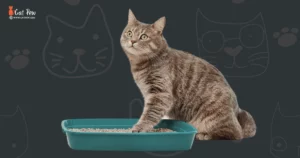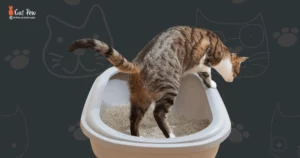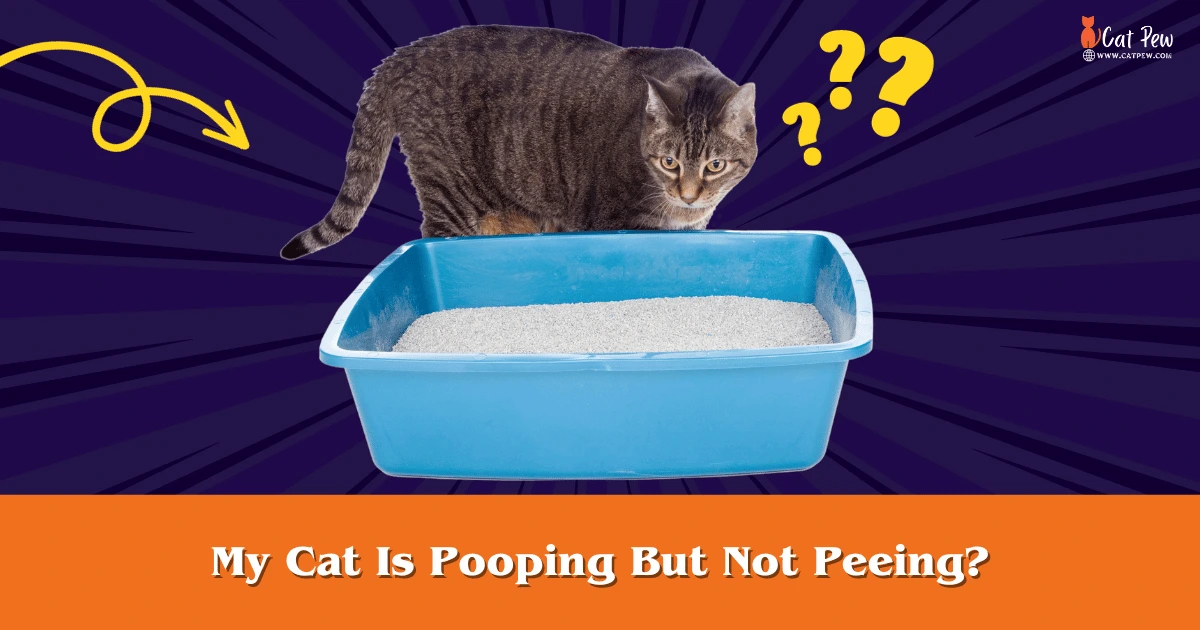My Cat Is Pooping But Not Peeing?
If your cat is pooping but not peeing, it could be a sign of a urinary blockage. This medical condition commonly occurs in male cats and can be life-threatening if not treated promptly.
Urinary blockage in cats occurs when there is an obstruction in the urethra, preventing urine from being expelled. While the cat may be able to defecate, it will struggle to urinate or produce only small amounts of urine. Other symptoms may include straining in the litter box, frequent licking of the genital area, and signs of discomfort or pain.
If you suspect your cat is experiencing a urinary blockage, it is crucial to seek immediate veterinary attention. The veterinarian will conduct a thorough examination to diagnose the issue and may recommend treatment options such as catheterization or surgery to relieve the obstruction. Prompt intervention is crucial to prevent complications and ensure the cat’s well-being.
Possible Reasons For Difficulty In Peeing

There are several possible reasons why your cat may be having difficulty peeing. One potential cause could be a urinary tract infection, which can make urination painful and lead to decreased or strained urination. Another possibility is the presence of urinary stones or crystals, which can obstruct the flow of urine and cause discomfort. In male cats, a common issue is a condition called Feline Lower Urinary Tract Disease (FLUTD), which can result in difficulty peeing due to inflammation or blockages in the urinary tract.
It’s important to monitor your cat for any signs of distress, such as frequent trips to the litter box without successfully producing urine or vocalizing during attempts to urinate. Additionally, if your cat is pooping but not peeing, it could indicate an underlying issue with their urinary system that requires prompt attention from a veterinarian.
Is your beloved cat having trouble peeing? It’s essential to investigate the possible reasons behind this issue as it could indicate an underlying health problem. Here are a few potential causes to consider:
Dehydration
One of the common causes of difficulty in peeing is dehydration. Like humans, cats must stay well-hydrated to maintain optimal urinary health. When a cat doesn’t consume enough water, their urine becomes concentrated and can lead to painful urination. Ensuring your cat has access to fresh water at all times is crucial for preventing dehydration.
Urinary Tract Infection (UTI)
A urinary tract infection (UTI) can also lead to difficulties in peeing. Bacteria can enter the cat’s urinary system and cause inflammation, leading to pain and discomfort during urination. If your cat is experiencing frequent trips to the litter box, straining while urinating, or displaying signs of distress, they may have a UTI. Consulting with your veterinarian is essential to diagnose and treat the infection.
Urinary Blockage Or Obstruction
Certainly, a urinary blockage or obstruction can be a serious concern when it comes to a cat’s ability to urinate. This can occur due to the presence of bladder stones, crystals, or even a tumour. When the flow of urine is impeded, your cat may experience significant discomfort and be unable to urinate properly. This is a critical condition that necessitates immediate veterinary attention to prevent further complications.
Stress Or Anxiety
Cats are sensitive creatures, and stress or anxiety can affect their urinary habits. Just like humans, cats may experience difficulty urinating when they are under significant stress or dealing with anxiety-inducing situations. Changes in the environment, introducing a new pet, or even moving to a new house can trigger such behaviours. Reducing stressors and offering a calm and supportive environment can help alleviate urinary issues caused by stress or anxiety.
Understanding The Symptoms

When it comes to our beloved feline friends, it’s essential to be in tune with their health and well-being. One of the common concerns that cat owners may face is when their cat is pooping but not peeing. Understanding the symptoms associated with this issue can help you identify the underlying cause and take appropriate action. Let’s delve into the key symptoms to look out for:
Frequent Trips To The Litter Box
If you notice that your cat is making more frequent trips to the litter box without producing any urine, this could be an indication of a problem. Cats are typically fastidious creatures, and a change in their litter box behaviour can be a sign that something isn’t quite right. Pay attention to any unusual patterns and monitor if your cat is spending more time in the litter box than usual.
Straining Or Discomfort During Urination
Another symptom to be aware of is if your cat appears to be straining or experiencing discomfort while trying to urinate. This could manifest as repeated squatting or posturing in the litter box, accompanied by vocalization or signs of pain. It’s essential not to dismiss these signs, as they may indicate an underlying urinary tract issue that requires medical attention.
Visible Blood In The Urine
If you observe any blood in your cat’s urine, taking this symptom seriously is crucial. Blood in the urine, also known as hematuria, could be a sign of a urinary tract infection, bladder stones, or even a more serious condition such as feline lower urinary tract disease (FLUTD). This symptom should prompt immediate veterinary evaluation to determine the cause and appropriate treatment.
Identifying and understanding these symptoms is the first step in addressing your cat’s pooping but not peeing issue. Remember that each cat’s situation is unique, and seeking professional veterinary advice is essential for accurate diagnosis and proper treatment. By staying proactive and attentive to your cat’s behaviour, you can help ensure their health and well-being.
Steps To Address The Issue At Home

Are you noticing that your cat is pooping but not peeing? This can be concerning as it indicates a potential problem with your cat’s urinary system. While it’s always recommended to consult with a veterinarian for a proper diagnosis and treatment plan, there are some steps you can take at home to help address the issue. By following these guidelines, you can support your cat’s urinary health and possibly alleviate the problem:
Encourage Increased Water Intake
One of the most important steps you can take is to encourage your cat to drink more water. Proper hydration is crucial for maintaining a healthy urinary system. Here are some ways you can achieve this:
- Ensure your cat always has access to fresh, clean water.
- Place multiple water bowls around the house to make your cat’s drinking convenient.
- Consider purchasing a cat fountain, as some cats are more attracted to running water.
- Try adding a little water to your cat’s wet food to increase their overall water intake.
Ensure a Clean And Accessible Litter Box
A cat’s litter box plays a vital role in their urinary health. It’s crucial to keep the litter box clean and easily accessible. Consider the following:
- Clean the litter box regularly. Aim for at least once daily, removing both faeces and clumps of urine-soaked litter.
- Use unscented litter, as some cats may be sensitive to strong fragrances.
- Provide multiple litter boxes, especially if you have more than one cat. This allows each cat to have their own space and reduces the likelihood of stress-induced urinary issues.
- Choose a litter box with low sides, especially for older cats or those with mobility issues. This makes it easier for them to enter and exit.
Reduce Stress And Provide A Calm Environment
Stress can contribute to urinary problems in cats. Creating a calm and stress-free environment can help prevent or alleviate the issue. Keep the following in mind:
- Ensure your cat has a quiet space where they can retreat and feel safe.
- Avoid sudden changes in routine or environment, as these can trigger stress.
- Provide environmental enrichment, such as interactive toys and scratching posts, to keep your cat mentally and physically stimulated.
- If you have multiple cats, ensure they each have their resources (litter box, food, water, etc.) to reduce competition and potential stress.
By implementing these steps, you can take proactive measures to address the issue of your cat pooping but not peeing at home. Remember that it’s always best to consult with a veterinarian for proper diagnosis and treatment.
When To Seek Veterinary Assistance

If you notice that your cat is pooping but not peeing, it could be a sign of an underlying health issue that requires veterinary attention. While occasional changes in bathroom habits can happen, persistent or worsening symptoms should never be ignored. Watching out for specific signs can help you determine when it’s time to seek veterinary assistance.
Persisting Or Worsening Symptoms
If your cat continues to poop but fails to pee for an extended period, it could indicate a potential problem. Regular urination is essential for cats to eliminate waste and maintain proper hydration. If your cat’s symptoms persist for more than 24 hours or worsen over time, it’s crucial to consult a veterinarian.
Inability To Urinate At All
In some cases, cats may experience a complete inability to urinate, a condition known as urinary retention. This can be incredibly painful for your furry friend and requires immediate veterinary assistance. Look out for signs such as your cat frequently visiting the litter box without producing any urine, straining while trying to urinate, or displaying discomfort when touched in the abdominal area. If you notice any of these symptoms, contact your veterinarian right away.
Signs Of Pain Or Distress
When your cat is pooping but not peeing, it’s essential to observe their behaviour closely for any signs of pain or distress. Cats may exhibit discomfort while urinating, such as vocalizing during the process, excessive licking of the genital area, or restlessness. Additionally, if your cat appears lethargic, loses appetite, or displays any unusual behavioural changes, it could indicate an underlying medical condition that warrants veterinary assistance.
Remember, as a responsible cat owner, you must prioritize your pet’s health. Don’t delay seeking veterinary assistance when your cat is experiencing persistent or worsening symptoms, unable to urinate, or showing signs of pain and distress. Early intervention can help prevent complications and provide the necessary treatment for your beloved furry companion.
Diagnosis And Treatment Options

When it comes to dealing with a cat that is pooping but not peeing, it is essential to identify the underlying cause and seek appropriate treatment quickly. This involves a veterinary examination and various tests to determine the root problem.
Veterinary Examination And Tests
Upon observing your cat’s unusual behaviour, it is crucial to take them to a veterinarian for a thorough examination. The veterinarian will conduct a series of tests to pinpoint the issue. These tests may include:
- Blood tests: A comprehensive blood panel helps to assess the cat’s overall health and detect any abnormalities.
- Urinalysis: This test involves analyzing a urine sample to identify any signs of infection, crystals, or other urinary tract issues.
- X-rays or ultrasounds: These imaging techniques can provide valuable information about the structure and function of the urinary system and help identify any obstructions or abnormalities.
- Physical examination: The veterinarian will carefully examine your cat’s abdomen and palpate the bladder to check for any signs of discomfort, blockages, or abnormal masses.
Possible Medication Or Surgical Intervention
Based on the diagnosis, your veterinarian will recommend suitable treatment options to address the underlying issue. These may include:
- Medication: If the cause of your cat not peeing lies in an infection or inflammation, the veterinarian may prescribe appropriate medication, such as antibiotics or anti-inflammatory drugs. These medications can help alleviate symptoms and clear the underlying issue.
- Surgical intervention: In cases where an obstruction or anatomical abnormality is identified, surgery may be necessary. This can involve removing blockages, repairing structural abnormalities, or addressing any other underlying problems preventing your cat from peeing normally.
It is important to note that the specific diagnosis and treatment options will vary depending on the individual cat and their particular condition. Hence, consulting with a veterinarian is crucial to developing an appropriate treatment plan tailored to your cat’s needs.
Frequently Asked Questions On My Cat Is Pooping But Not Peeing
Why is my cat pooping but not peeing?
This could indicate a potential health issue and should be assessed by a veterinarian.
When Should I Worry If My Cat Hasn’t Peed?
If your cat hasn’t peed, it is concerning. Seek veterinary attention as it could indicate a blockage or urinary issue, which can be serious. Monitoring your cat’s litter box habits and seeking prompt veterinary care is essential for their health and well-being.
What are some possible reasons for this behaviour in cats?
Urinary tract infections, blockages, stress, or kidney issues could be contributing factors.
How long can a cat go without peeing?
Cats can typically hold their urine for up to 24-48 hours, but it’s important to monitor them regularly.
What happens if my cat doesn’t pee for 2 days?
If your cat hasn’t peed for 2 days, it could indicate a urinary blockage or other serious health issue. Contact your vet immediately.
How Can I Stimulate My Cat To Pee?
To stimulate your cat to pee: 1) Ensure their litter box is clean, accessible, and in a quiet location. 2) Try using cat pheromone sprays or attractants, and establish a routine for feeding and bathroom breaks. 3) If issues persist, consult a veterinarian for further guidance.
Can dehydration cause a cat not to pee?
Yes, dehydration can lead to decreased urine production in cats, so it’s crucial to ensure they have access to fresh water at all times.
Why Is My Cat Not Peeing But Acting Fine?
If your cat is not peeing but acting fine, it may be a sign of a urinary tract issue. It’s essential to monitor your cat’s behaviour and consult a veterinarian for proper diagnosis and treatment.
What Can I Give My Cat To Help Her Pee?
To help your cat pee, provide plenty of fresh water and use a clean litter box. In case of any urinary problems, consult a veterinarian for appropriate diagnosis and treatment.
What are the signs that my cat may be experiencing urinary issues?
Straining to urinate, blood in urine, frequent attempts at urination, or vocalizing while using the litter box are all signs of concern.
Conclusion
To sum up, understanding why your cat is pooping but not peeing is crucial for their health and well-being. It could be a sign of various underlying issues, such as urinary tract infections or bladder stones. It is essential to observe any changes in their behaviour, consult with a veterinarian, and follow their advice for diagnosis and treatment.
Remember, a healthy cat is a happy cat.

Winston
I'm Winston, the author of this feline-focused (Catpew.com) blog . My love for cats goes back to my childhood, when I spent countless hours playing with my family's tabby, Mittens. This furry friend instilled in me a deep appreciation for the unique personalities, playful nature, and unconditional love that cats offer.

